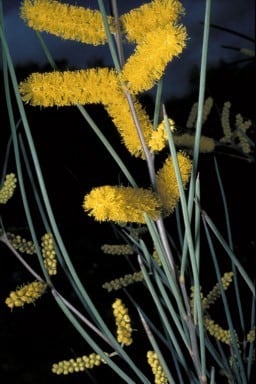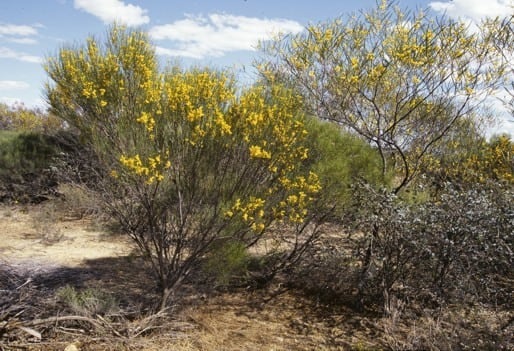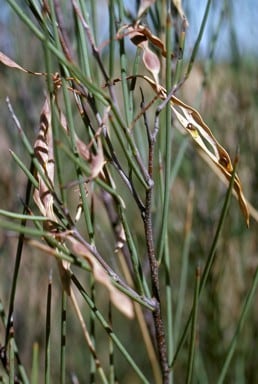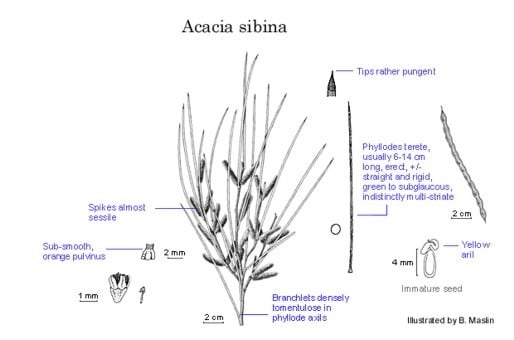Acacia sibina Maslin
WATTLE
Acacias of Australia
Family
Fabaceae
Distribution
Occurs from Mullewa SE to near Wubin, and widely scattered eastwards to Warburton and near Queen Victoria Spring, central W.A.
Description
Shrub 1-3 m high. Branchlets glabrous except tomentulose in phyllode axils. Phyllodes erect, straight to slightly curved, terete, 6-14 (-22) cm long, 1-2 mm diam., pungent, rigid, green to subglaucous, glabrous, indistinctly striate; pulvinus subsmooth, orange, slightly flared basally. Inflorescences simple, 2 per axil; peduncles 1.5-4 (-5) mm long, ± puberulous; spikes 7-26 mm long, to 7 mm diam., moderately densely flowered, golden. Flowers 5-merous; sepals 3/4-5/6-united, with broadly triangular lobes. Pods linear, raised over and constricted between seeds, to 12 cm long, (3-) 4-6 mm wide, firmly chartaceous, glabrous. Seeds longitudinal, elliptic, 3.5-4 mm long, glossy, dark brown, paler around areole; aril yellow.
Habitat
Grows mostly on plains in sand, gravelly sand and loam, in heath, Acacia scrub and shrubland and low woodland.
Specimens
W.A.: Wilroy townsite, G.Phillips for A.M.Ashby 4864 (CANB, K, NY, PERTH); 33.8 km NE of Laverton, A.S.George 8092 (PERTH); 21.5 km N of Perenjori towards Morawa, B.R.Maslin 5070 (MEL, PERTH); Gibson Desert, B.R.Maslin 5671 (MO, PERTH); N of Queen Victoria Spring Nature Reserve, A.S.Weston 14770A (PERTH).
Notes
Acacia stereophylla has a similarly smooth, flared pulvinus but differs most obviously from A. sibina by its non-pungent phyllodes which are commonly flat (terete to subterete phyllode forms, described as A. stereophylla var. cylindrata, are rare). Seemingly related to A. intorta and superficially similar to A. cylindrica and A. aciphylla.
FOA Reference
Data derived from Flora of Australia Volumes 11A (2001), 11B (2001) and 12 (1998), products of ABRS, ©Commonwealth of Australia
Author
Minor edits by J.Reid & J.Rogers
R.S.Cowan
This identification key and fact sheets are available as a mobile application:
URL: https://apps.lucidcentral.org/wattle/
© Copyright 2018. All rights reserved.












